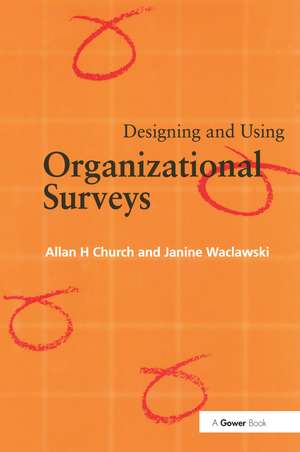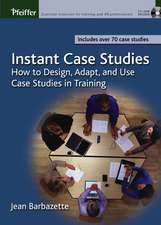Designing and Using Organizational Surveys
Autor Allan H. Church, Janine Waclawskien Limba Engleză Hardback – 26 oct 1998
| Toate formatele și edițiile | Preț | Express |
|---|---|---|
| Hardback (2) | 562.03 lei 6-8 săpt. | |
| Wiley – 5 noi 2001 | 562.03 lei 6-8 săpt. | |
| Taylor & Francis – 26 oct 1998 | 682.11 lei 6-8 săpt. |
Preț: 682.11 lei
Preț vechi: 915.17 lei
-25% Nou
Puncte Express: 1023
Preț estimativ în valută:
130.54€ • 136.11$ • 108.49£
130.54€ • 136.11$ • 108.49£
Carte tipărită la comandă
Livrare economică 20 martie-03 aprilie
Preluare comenzi: 021 569.72.76
Specificații
ISBN-13: 9780566079757
ISBN-10: 0566079755
Pagini: 200
Dimensiuni: 156 x 234 x 21 mm
Greutate: 0.53 kg
Ediția:1
Editura: Taylor & Francis
Colecția Routledge
Locul publicării:Oxford, United Kingdom
ISBN-10: 0566079755
Pagini: 200
Dimensiuni: 156 x 234 x 21 mm
Greutate: 0.53 kg
Ediția:1
Editura: Taylor & Francis
Colecția Routledge
Locul publicării:Oxford, United Kingdom
Cuprins
Contents: Introduction; Step 1 Pooling Resources; Step 2 Developing a World Class Survey; Step 3 Communicating Objectives; Step 4 Administering the Survey; Step 5 Interpreting Results; Step 6 Delivering the Findings; Step 7 Learning into Action; References; Subject Index; Index of Authors Cited.
Notă biografică
Allan H Church holds both a master’s degree and a doctorate in organizational psychology from Columbia University. Before becoming a full-time consultant, he worked for IBM on communications measurement and corporate personnel issues. Dr Church co-teaches a course at Columbia University Teachers’ College on the application of data-based methods for organizational change. He has published more than 70 articles in academic and practitioner journals and is the editor of both The Industrial-Organizational Psychologist and the Organization Development Journal. Janine Waclawski received her BA in psychology from the State University of New York, and her MPhil and PhD from Columbia University. She has worked for IBM, for the City of New York, has published numerous articles on data-based methods for organizational change and is involved in a number of teaching programmes. Dr Waclawski is active in several professional organizations and serves on the editorial board of the Organization Development Practitioner, the Organization Development Journal and the International Journal of Organizational Analysis. Both authors are principal consultants with W Warner Burke Associates, a New York-based consultancy specializing in the design and implementation of large-scale organizational surveys.
Recenzii
'The many tools CW (Church and Waclawski) offer alone make this book a treasure chest ... would make an excellent text for a master's level course on this subject' Personnel Psychology, Spring 2000
Descriere
Allan H Church and Janine Waclawski have drawn on their extensive experience in this field to develop a seven-step model covering the entire process, from initiation to final evaluation. They explain in detail how to devise and administer different types of organizational surveys, leading the reader systematically through the various stages involved. Their text is supported throughout by examples, specimen documentation, work sheets and case studies from a variety of organizational settings. They pay particular attention to the political and human sensitivities concerned and show how to surmount the many potential barriers to a successful outcome.




















